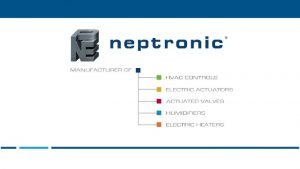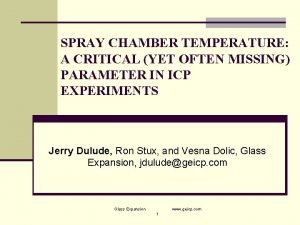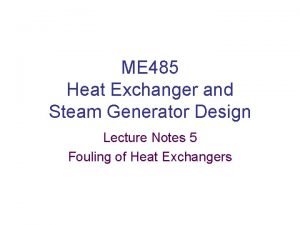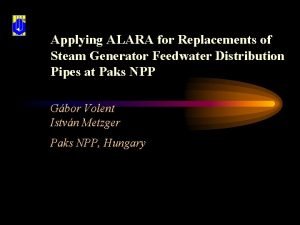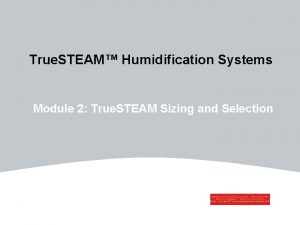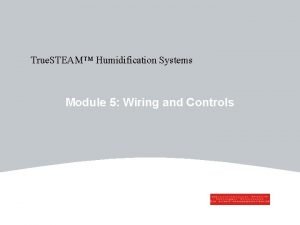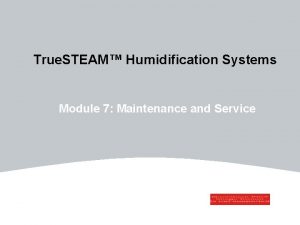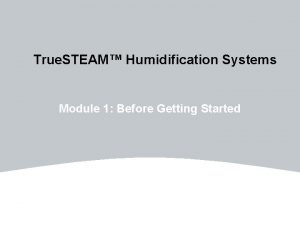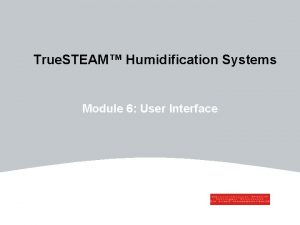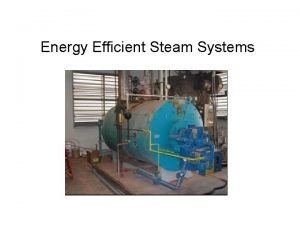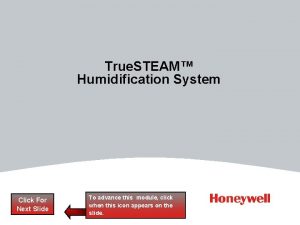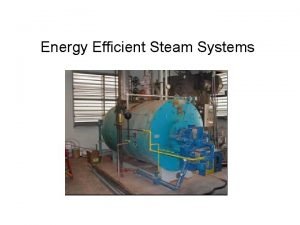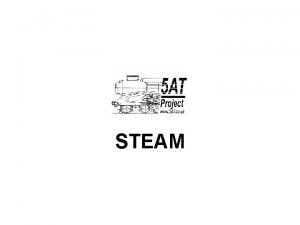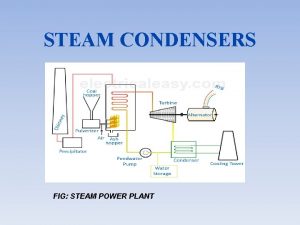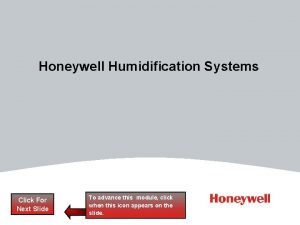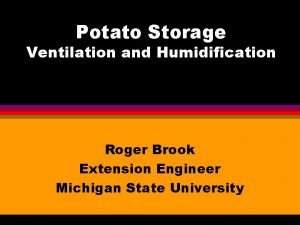True STEAM Humidification Systems Module 2 True STEAM













- Slides: 13

True. STEAM™ Humidification Systems Module 2: True. STEAM Sizing and Selection

Module 2: Selecting & Sizing • Understanding Industry Standards & Guidelines for sizing • Calculating a home's humidity load requirements • Trade-offs of different humidifier types Key Learning Selecting the Right Humidifier for Every Job

Sizing – Establishing a Baseline • AHRI sets rating guidelines for humidifiers. (610 Guideline F) • Definitions - Capacity rating = Maximum output in 24 -hour period - Load requirement = Minimum output required to achieve 35%RH with external variables considered. • Traditionally, ratings advertised based on capacity *Based on a tight home with people living in it. • A better approach Base humidifier selection on LOAD REQUIREMENT to minimize excessive runtime, operating costs, and dealer callbacks.

Sizing – Refining the message • Assume fixed value 35%RH and hours needed to achieve. • Segmented by area size, average daily run times. • A bypass humidifier is rated at 12 GPD - Why not use this? - 12 GPD based on 120 F air passing through it - In a 2000 sq ft space, equals 13 hours of furnace run time - Furnace runtime more $$$ than True. STEAM in this example.

Sizing – True. STEAM Recommendations • HM 506: 500 -1800 for <80% daily run (<20 hr) • HM 509: 1000 -2300 for <80% daily run (<20 hr) • HM 512: 1500 -3000 for <80% daily run (<20 hr) • Within these home sizes, units should hit ideal humidity without running all day. • Why do some of the numbers overlap? - Variables within home affect these average run rates.

Variables within the home that affect humidity • Insulation - Tight, average or loose? • Ceiling height - Higher ceilings = smaller ft 2 coverable (larger total volume) • Indoor temperature - Higher temps require higher RH% to achieve desired comfort • Control settings • Ventilation – What sources of ventilation are there? - Fireplace flues - ERV/HRV/motorized dampers - Open windows - Old homes breathe more

Insulation – AHRI definition of structure type • 'Tight' = Well insulated with vapor retarders, tight storm doors, windows with weather stripping, dampered fireplace and using 1/2 air changes per hour for ventilation. • 'Average' = Insulated with vapor retarders, loose storm doors and windows, dampered fireplace with 1 air change per hour for ventilation. • 'Loose' = Generally built before 1930 with little or no insulation, no storm doors, no insulated windows, no weather stripping, no vapor retarders, undampered fireplace. Uses 1 -1/2 air changes per hour for ventilation. • How does this translate to load requirements? Square footage

Ceiling height • AHRI sets load requirements for a fixed 8 -ft ceiling height • Higher ceilings, open foyers, split level, stairway air shafts add to total CUBIC feet - Higher height = Lower width/length served (i. e. lower ft 2) • If ceiling height >8 ft, refer to ft 3, not ft 2. - Multiplying ft 2 by ceiling height equals ft 3 • How does this translate to load requirements? 10 ce 00 ft 2 ilin g @8 ft 12 ce 50 ft 2 ilin g @8 ft 15 ce 00 ft 2 ilin g @8 ft 20 ce 00 ft 2 ilin g @8 - ft 25 ce 00 ft 2 ilin g @8 - ft 30 ce 00 ft 2 ilin g @8 - ft

Frost Protection • Auto-humidity controls reduce and increase indoor humidity based on outdoor conditions. • What Honeywell Frost Protect reads… Frost setting limits achievable humidity.

Ventilation • Ventilation sources - Fireplaces w If fireplace present, ensure flue is kept shut when not in use - Forced air ventilators w HRVs and motorized dampers exhaust humidity - Open windows w Drier outside air infiltrates home, exhausts humidified air - Old homes breathe more w Pre-1985 buildings can be assumed to be ‘Average’ or ‘Loose’ insulation, unless retrofitted after. • How does this translate to load requirements? 10 00 ft 2 12 50 @ 8 -f tc 15 00 ft 2 @ eil 8 -f ing tc eil in g ft 2 @ 20 00 8 -f t ce ilin g 25 ft 2 @ 8 -f tc eil ing 00 30 ft 2 @ 8 -f tc 00 ft 2 @ 8 -f tc eil ing

Recommendations on Humidity with Ventilation • Educate homeowner on proper fireplace upkeep. • Ventilators – Recommend Energy Recovery style which retain moisture in home. • Shut and lock windows. • If average or loose fitting, upsize humidifier, or install multiple units if greater than 12 GPD is required.

Support Materials • Detailed Training Materials on Sizing Available! • Visit www. forwardthinking. honeywell. com - Click on Humidification • Enter literature form: #50 -1098: Proper Sizing #50 -1066: Selecting a Humidifier

Recap • Understanding Industry Standards & Guidelines for sizing • Calculating a home's humidity load requirements • Trade-offs of different humidifier types Key Learning Selecting the Right Humidifier for Every Job
 Humidification agroalimentaire
Humidification agroalimentaire Spray chamber for humidification
Spray chamber for humidification Steam steam generator fouling
Steam steam generator fouling Dittus boelter equation
Dittus boelter equation Steam steam generator erosion
Steam steam generator erosion C device module module 1
C device module module 1 Module 10 topic 2 drivers ed
Module 10 topic 2 drivers ed Module 4 operating systems and file management
Module 4 operating systems and file management Sympathetic nervous system
Sympathetic nervous system 102 dr
102 dr Chapter 2 jesus christ true god and true man
Chapter 2 jesus christ true god and true man Decision support systems and intelligent systems
Decision support systems and intelligent systems Engineering elegant systems: theory of systems engineering
Engineering elegant systems: theory of systems engineering Embedded systems vs cyber physical systems
Embedded systems vs cyber physical systems
